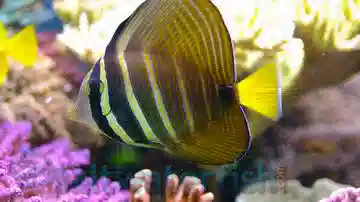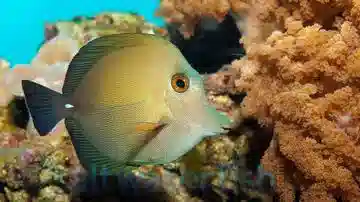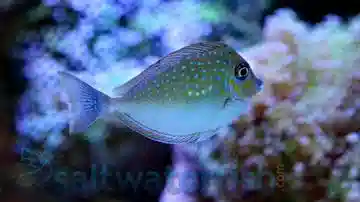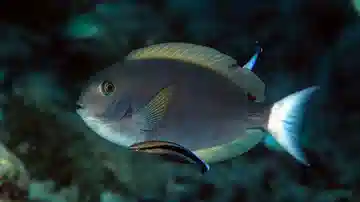Thompson's Tang
Acanthurus thompsoni
(1 Reviews)
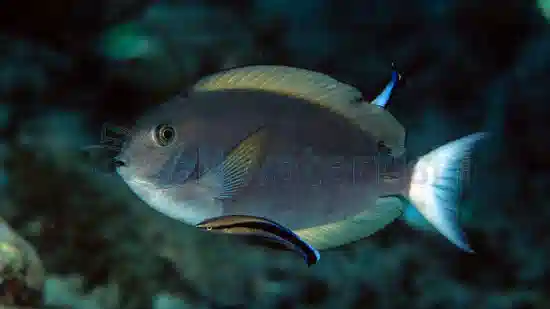
Thompson's Tang
Acanthurus thompsoni
(1 Reviews)
{{ item.name }}
Size: {{ item.extra_field_3 }}
${{ getFormattedPrice(item.saleprice) }} ${{ getFormattedPrice(item.price) }}
To join the waiting list, click here
Free Shipping
With
$199.00
or more in Marine Life.
More details...
Thompson's Tang Care Facts
| Care Level: | Moderate |
|---|---|
| Temperament: | Peaceful |
| Diet: | Omnivore |
| Origin: | Hawaii |
| Minimum Tank Size: | 250 Gallons |
| Acclimation Time: | 3+ Hours |
| Reef Safe: | Yes |
Thompson's Tang (Acanthurus thompsoni), also known as Thompson's Surgeonfish, is a unique and rather rare fish in the aquarium trade. It has a dark brown or blue body with yellow highlights on its fins. They naturally occur in large schools among deep channels and drop offs. They dark waters with high current and oxygen. They reach a size of 11 inches and require an aquarium of at least 250 gallons, due to their need for space to swim. They typically feed on small plankton and other fish eggs, and should be fed a variety of foods to keep a well-balanced diet. They should have access to seaweed or macro algae regularly.
Thompson's Tang (Acanthurus thompsoni) Care Guide
The Thompson's Tang, scientifically known as Acanthurus thompsoni, is a remarkable addition to a saltwater marine aquarium. In this comprehensive care guide, we will provide you with essential information on properly caring for the Thompson's Tang. We will cover its habitat, reef compatibility, size, lifespan, diet in captivity, aquaculture availability, compatibility with other marine life, sexual dimorphism, juvenile to adult coloration changes, temperament, tank requirements, water conditions, common names, and the reasons why you should consider buying the Thompson's Tang from Saltwaterfish.com.
Habitat of Thompson's Tang:
Thompson's Tang is commonly found in the Indo-Pacific region and Hawaii. Its natural habitat includes coral reefs and the rocky coastlines of tropical waters. Understanding its origins is crucial for creating a suitable environment in your aquarium.
Reef Compatibility of Thompson's Tang:
The Thompson's Tang is generally considered reef safe. However, like many tang species, it may occasionally nip at soft and hard corals or other sessile invertebrates. Providing ample marine algae can help divert their grazing behavior from corals and prevent potential damage.
Size and Lifespan of Thompson's Tang:
When fully mature, Thompson's Tang can reach sizes of up to 10 inches (25 cm). With proper care, these fish can have a lifespan of 5 to 10 years, making them a long-term commitment to your marine aquarium.
Thompson's Tang Diet in Captivity
In captivity, Thompson's Tangs are herbivores. Their diet primarily consists of algae and other plant-based foods. Offer them high-quality marine flakes, pellets, and frozen herbivore foods. Supplement their diet with fresh or dried marine algae, such as nori or spirulina sheets. A varied diet helps ensure their optimal health and vibrant coloration.
Aquaculture and Availability of the Thompson's Tang:
Thompson's Tangs are not available through aquaculture. However, many specimens in the aquarium trade are still wild-caught. Sourcing your fish from reputable suppliers like Saltwaterfish.com is crucial to ensure the fish has been responsibly harvested and acclimated to captivity.
Compatibility of Thompson's Tang with Other Fish and Invertebrates:
Thompson's Tangs are generally peaceful and can coexist with various marine fish and invertebrates. They may become territorial with other tangs, especially in smaller tanks. To prevent conflicts, provide a spacious tank with hiding places and ample swimming space.
Sexual Dimorphism of Thompson's Tang
Thompson's Tangs do not display significant sexual dimorphism, meaning that males and females have similar physical characteristics and coloration.
Juvenile to Adult Coloration Changes in Thompson's Tang
Juvenile Thompson's Tangs have a beautiful light-blue body with a striking orange border along their dorsal and anal fins. As they mature into adults, their coloration may shift towards a more vibrant blue body with a brighter orange accent on the tail and fins, creating a stunning visual appeal.
Temperament of T
Thompson's Tangs are generally peaceful, but like many tangs, they can become territorial when housed with other tang species or when introduced to smaller tanks. Therefore, it is essential to monitor their behavior and tank mates closely.
Tank Requirements:
To ensure the well-being of your Thompson's Tang, provide a tank size of at least 250 gallons (approximately 800 liters). A larger tank with ample swimming space is even better for this active swimmer. Maintain stable water conditions, including a pH level between 8.1 and 8.4, a salinity level of 1.020-1.025, and a consistent temperature range of 74-82°F (23-28°C). Proper water flow, a protein skimmer, and regular water changes are essential for maintaining water quality.
Common Names:
The Thompson's Tang is also known by other common names, including the Whitecheek Tang and Thompsons' Surgeonfish.
Compatible Tank Mates for the Thompson's Tang:
When selecting tank mates for your Thompson's Tang, consider the following five specific species that are less likely to provoke territorial conflicts:
- Flame Angelfish (Centropyge loriculus)
- Coral Beauty Angelfish (Centropyge bispinosa)
- Fire Shrimp (Lysmata debelius)
- Orchid Dottyback (Pseudochromis fridmani)
- Six-Line Wrasse (Pseudocheilinus hexataenia)
Why Choose the Thompson's Tang from Saltwaterfish.com:
The Thompson's Tang is an attractive and peaceful herbivore, making it a valuable addition to a marine aquarium. By sourcing your fish from reputable suppliers like Saltwaterfish.com, you can be confident that it has been well-acclimated to captivity, reducing stress and increasing its chances of thriving in your marine aquarium.
In conclusion, Thompson's Tang is a captivating and peaceful herbivore that can add vibrance and life to your marine aquarium. By providing a well-maintained tank, a balanced diet, and suitable tank mates, you can enjoy the beauty of this species while contributing to the overall health of your aquatic ecosystem.
Beautiful Thompson's Tang swims in out of the rock formation in the saltwater fish tank. Healthy and energetic after acclimation.
Reviewed by: Orlando Asumata on Dec. 31, 2021


